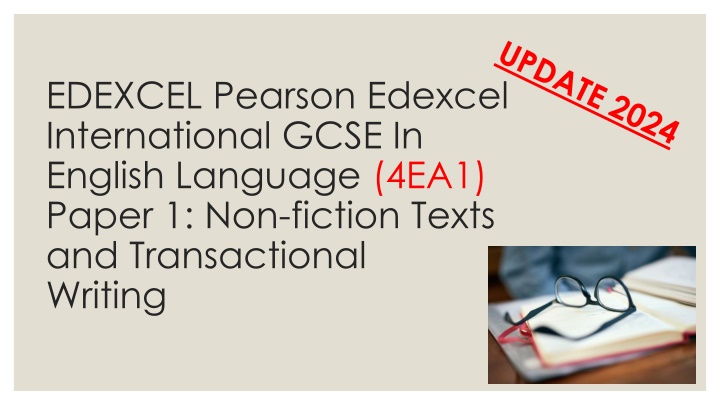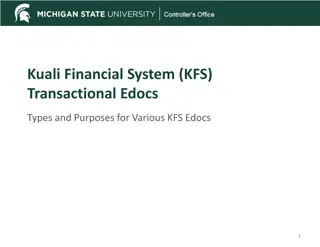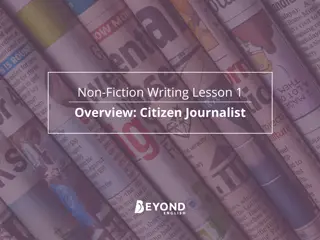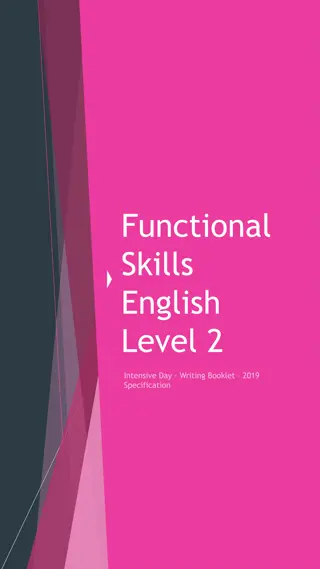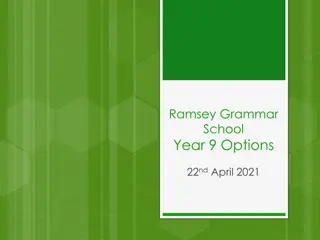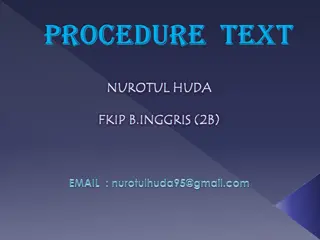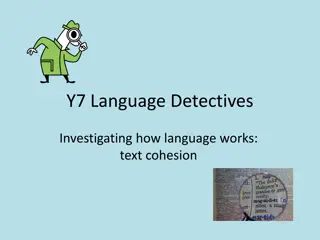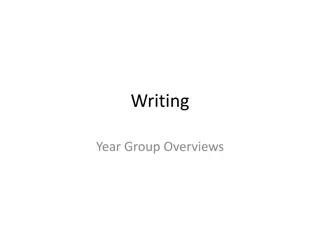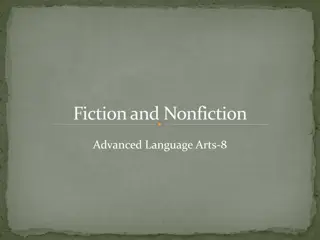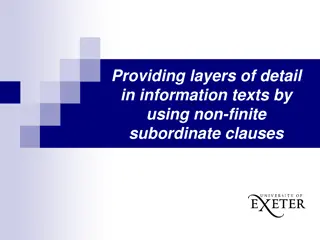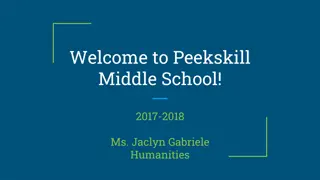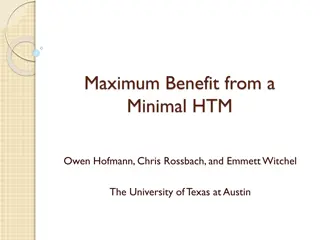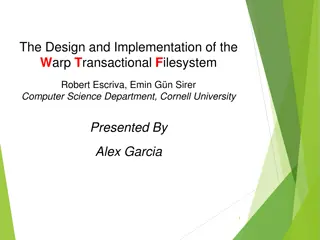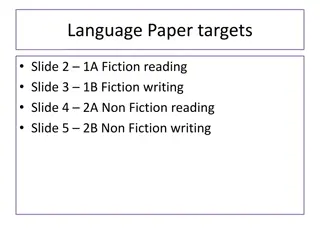Non-fiction Texts and Transactional Writing in English Language
This content outlines a detailed overview of the Edexcel Pearson Edexcel International GCSE in English Language (4EA1) Paper 1, focusing on non-fiction texts and transactional writing. It includes sections on reading comprehension, inference questions, and transactional writing tasks, providing guidelines and examples. The paper duration, structure, and question types are explained to help students prepare effectively for the examination.
Download Presentation

Please find below an Image/Link to download the presentation.
The content on the website is provided AS IS for your information and personal use only. It may not be sold, licensed, or shared on other websites without obtaining consent from the author.If you encounter any issues during the download, it is possible that the publisher has removed the file from their server.
You are allowed to download the files provided on this website for personal or commercial use, subject to the condition that they are used lawfully. All files are the property of their respective owners.
The content on the website is provided AS IS for your information and personal use only. It may not be sold, licensed, or shared on other websites without obtaining consent from the author.
E N D
Presentation Transcript
EDEXCEL Pearson Edexcel International GCSE In English Language (4EA1) Paper 1: Non-fiction Texts and Transactional Writing
EDEXCEL Pearson Edexcel International GCSE In English Language (4EA1) Paper 1: Non-fiction Texts and Transactional Writing duration: for 2 hours 15 minutes Total of 90 marks available Weight: 60% of total (4EA1) grade Reading Section (approximately 45 marks/ 1hr. 20 minutes): 3 short answer questions from anthology text + unseen text (Q1-3) 1 extended writing on the anthology text (Q4) 1 comparison question (anthology text vs. unseen text) (Q5) Transactional Writing Section (approximately 45 marks/ 40 min): Choose 1 out 2 questions to write (Q6 or Q 7) Edit, correction (15 min)
Q 1 -2 Reading comprehension and inference Q 1 What will I need to do? (2 marks) Locate a specific piece of information, such as a word or phrase, from the text. Q1.The following questions are based on Text One and Text Two in the Source Booklet. Text One: Motherwell 1 From lines 8 10, select two words or phrases that show what the writer enjoyed about her first day at school. 1 ............................................................................................................. 2 ............................................................................................................. ............... (Total for Question 1 = 2 marks)
Q 1 -2 Reading comprehension and inference Q In your own words, explain the writer s thoughts and feelings? (4 marks) Locate two pieces of information in the text. There may be more than two available, and the information may be surface meaning (such as a fact) or implied meaning (such as a suggestion or hint). You can use specific quotations from the text or your own words, or both. Q2 Look again at lines 17 26. In your own words, explain the writer s thoughts and feelings. ............................................................................................................. ............................................................................................................. ............................................................................................................. ............................................................................................................. ............................................................................................................. (Total for Question 2 = 4 marks)
Q 3 describe (5 marks) Top tips: Make sure you refer to both language and structure in your answer you can t get high marks if you don t reference both. Use the line references to get to the appropriate piece of text quickly. Remember to use short, precise quotations from the text. It s not enough to just identify the techniques being used you must explain how they are effective. Q3. From lines 56 68, describe the argument between the writer (Deborah) and her parents. You may support your points with brief quotations. ............................................................................................................. ............................................................................................................. ............................................................................................................. (Total for Question 3 = 5 marks)
Q 4 authors technique and readers effects (5 marks) Top tips: Make sure you refer to both language and structure in your answer you can t get high marks if you don t reference both. Use the line references to get to the appropriate piece of text quickly. Remember to use short, precise quotations from the text. It s not enough to just identify the techniques being used you must explain how they are effective. Q4. How does the writer, Adeline Yen Mah, use language and structure in Text Two to interest and engage the reader? You should support your answer with close reference to the extract, including brief quotations .................................................................................................. ............................................................................................................. ............................................................................................................. (Total for Question 3 = 5 marks)
Q 4 analysis example 1 Read the following passage carefully. Then answer the question that follows. Passage: "The old house stood at the end of the lane, its weathered fa ade bearing the scars of time. Ivy tendrils crept up its walls, weaving intricate patterns that seemed to whisper secrets of centuries past. The windows, though once grand, now gazed out with a melancholic air, as if mourning the memories they held within. To the casual observer, it was just a dilapidated building, but to Emily, it was a treasure trove of stories waiting to be uncovered." Question 3: How does the author use language to create a sense of mystery and intrigue in the passage?
Q 4 analysis example 1 Model Answer: The author effectively uses language techniques to create mystery around the old house. Vivid imagery describes its weathered appearance, hinting at a rich history. Personification gives the house life, with windows "gazing out" and "mourning memories." Powerful language like "whisper secrets" and "treasure trove of stories" adds to the intrigue. Conseqyuently, these techniques draw readers into the enigmatic atmosphere, compelling them to explore the secrets of the house.
Q 4 analysis example 2 Read the following passage carefully. Then answer the question that follows. Passage: "The moon hung low in the sky, casting a silvery glow over the deserted streets below. Shadows danced on the walls, their shapes twisting and turning with each flicker of light. A lone figure moved through the darkness, its footsteps echoing against the cobblestones. There was an air of mystery surrounding the night, as if secrets lurked in every corner, waiting to be discovered." Question 3: How does the author use language to create a sense of mystery and anticipation in the passage?
Q 4 analysis example 2 Model Answer: The author successfully creates a mysterious atmosphere in the passage through vivid imagery, personification, and sensory language. Vivid imagination phrases like "shadows danced" and "twisting with each flicker of light" paint an eerie picture, while the moon's "silvery glow" adds to the sense of the unknown. Personification, such as shadows "dancing" and footsteps "echoing," gives life to the setting. Sensory details like the "air of mystery" and "secrets lurking" build suspense, drawing the reader into the deserted streets at night. As a result, these techniques create anticipation and invite exploration of the hidden secrets within the darkness.
Q 4 analysis example 3 Passage: "The forest was a realm of shadows and whispers, where ancient trees loomed like sentinels guarding secrets buried deep within their roots. Shafts of sunlight pierced the dense canopy, casting dappled patterns on the forest floor. Every rustle of leaves, every crack of a twig, seemed to echo with the weight of untold stories. It was a place where time stood still, and the boundaries between reality and fantasy blurred into one." Question 3: How does the author use language to evoke a sense of mystery and enchantment in the passage?
Q 4 analysis example 3 Model answer: In this captivating passage, the author skillfully uses language to immerse the reader in the mysterious atmosphere of the forest. Rich imagery paints a vivid picture of the forest as a realm of shadows and whispers, with ancient trees looming like sentinels. Sensory language, including descriptions of sunlight piercing the canopy and every rustle of leaves, heightens the tension and anticipation. Personification gives the trees agency, suggesting hidden secrets within their roots. The author's choice of language blurs the boundaries between reality and fantasy, inviting readers to lose themselves in the enchanting atmosphere. Therefore, through imagery, sensory language, personification, and choice of language, the author creates a captivating sense of mystery and enchantment in the forest.
Q5 comparing texts based on both Text One and Text Two Q5. Compare how the writers present their ideas and perspectives about their experiences. Support your answer with detailed examples from both texts, including brief quotations . ............................................................................................ ............................................................................................................. ............................................................................................................. . ............................................................................................ ............................................................................................................. ............................................................................................................. (Total for Question 5 = 22 marks)
Q5 comparing text Example 1 (1/3) Question 5:Question 5: Compare how the writers present the setting and reaction of the protagonists. Support your answer with detailed examples from both texts, including brief quotations. (22 marks) Text 1: Anthology Extract [Extract from "The Yellow Wallpaper" by Charlotte Perkins Gilman] I am sitting by the window now, up in this atrocious nursery, and there is nothing to hinder my writing as much as I please, save lack of strength. John is away all day, and even some nights when his cases are serious. I am glad my case is not serious! But these nervous troubles are dreadfully depressing. John does not know how much I really suffer. He knows there is no reason to suffer, and that satisfies him. Of course it is only nervousness. It does weigh on me so not to do my duty in any way! I meant to be such a help to John, such a real rest and comfort, and here I am a comparative burden already!
Q5 comparing text Example 1 (2/3) Text 2: Unseen Text [Unseen Extract] I sit in my room, surrounded by books and papers, with the soft glow of the lamp casting a warm light over the cluttered desk. Outside, the wind howls and rain lashes against the windowpanes, but inside, I am cocooned in my own little world. As I delve into the pages of my latest novel, I find myself transported to another time and place, where the worries of the present melt away. The characters come alive before me, their trials and triumphs unfolding in vivid detail. Despite the chaos outside, I find solace in the written word, losing myself in stories of love, adventure, and intrigue. In these moments, the boundaries between reality and fiction blur, and I am free to roam the realms of imagination.
Q5 comparing text Example 1 (3/3) Model Answer In both "The Yellow Wallpaper" by Charlotte Perkins Gilman and the unseen extract, the protagonists find themselves in isolated settings, but their experiences and reactions differ significantly. In "The Yellow Wallpaper," the narrator is confined to a nursery by her husband, John, who believes he knows what is best for her. She expresses feelings of helplessness and frustration, as she is unable to fulfill her duties and feels like a burden. The oppressive atmosphere is palpable as she describes her husband's ignorance of her true suffering. Conversely, the protagonist of the unseen extract appears to find solace in solitude. Surrounded by books and papers, they describe feeling cocooned in their own world, shielded from the storm raging outside. The soft glow of the lamp and the immersive power of literature provide comfort and escape from reality. While both texts explore themes of confinement and isolation, they offer contrasting perspectives on the experience. In "The Yellow Wallpaper," confinement is suffocating and oppressive, leading to feelings of despair and frustration. In contrast, the protagonist of the unseen extract finds refuge and solace in their solitude, embracing the opportunity for introspection and escape. As a result, both texts highlight the profound impact of isolation on individuals, but they present contrasting responses to confinement, offering insights into the complex nature of human experience.
Q5 comparing text Example 2 (1/3) Question 5: Compare how the writers present the theme of tranquility and peace and perspectives reflected . Support your answer with detailed examples from both texts, including brief quotations. (22 marks) Text 1: Anthology Extract [Extract from "The Great Gatsby" by F. Scott Fitzgerald] He smiled understandingly - much more than understandingly. It was one of those rare smiles with a quality of eternal reassurance in it, that you may come across four or five times in life. It faced - or seemed to face - the whole external world for an instant, and then concentrated on you with an irresistible prejudice in your favour. It understood you just so far as you wanted to be understood, believed in you as you would like to believe in yourself, and assured you that it had precisely the impression of you that, at your best, you hoped to convey. Precisely at that point it vanished - and I was looking at an elegant young rough-neck, a year or two over thirty, whose elaborate formality of speech just missed being absurd. Some time before he introduced himself I'd got a strong impression that he was picking his words with care.
Q5 comparing text Example 2 (2/3) Text 2: Unseen Text [Unseen Extract] As the sun dipped below the horizon, casting a warm orange glow across the sky, I couldn't help but feel a sense of peace wash over me. The gentle rustle of leaves in the breeze and the distant chirping of crickets created a serene atmosphere, far removed from the chaos of everyday life. I closed my eyes and took a deep breath, allowing myself to fully immerse in the tranquility of the moment. The worries and stresses of the day melted away, replaced by a profound sense of calm and contentment. In this fleeting moment of stillness, I felt connected to something greater than myself. Nature seemed to whisper secrets of the universe, and I listened with an open heart, embracing the beauty and wonder that surrounded me.
Q5 comparing text Example 2 (3/3) Model Answer Both "The Great Gatsby" by F. Scott Fitzgerald and the unseen extract explore the theme of tranquility and inner peace, but they do so in different contexts and through contrasting perspectives. In "The Great Gatsby," the protagonist encounters a mysterious and enigmatic character who exudes a sense of peace and understanding. The smile described in the passage carries a quality of eternal reassurance, conveying a profound sense of calm and contentment. Despite the superficial formality of the character's speech, there is a genuine connection and understanding that transcends words. This moment of tranquility offers a brief respite from the complexities of life, allowing the protagonist to momentarily escape into a world of reassurance and understanding. In contrast, the unseen extract describes a tranquil moment in nature, where the protagonist finds solace and peace amidst the beauty of the natural world. The description of the sunset and the gentle rustle of leaves evokes a sense of serenity and calm, creating a peaceful atmosphere far removed from the chaos of everyday life. In this moment of stillness, the protagonist feels connected to something greater than themselves, finding solace in the beauty and wonder of the universe. While both texts explore the theme of tranquility and inner peace, they do so through different contexts and perspectives. "The Great Gatsby" presents a moment of reassurance and understanding between characters, while the unseen extract depicts a moment of solace and connection with nature. Overall, both texts highlight the importance of finding moments of tranquility amidst the chaos of life, whether through human connection or communion with the natural world.
Q 6-7 transactional writing What will I need to do? Choose one of two possible tasks. These will both require you to write an engaging, imaginative fiction piece which could be based on your real experiences or entirely made up. It should be appropriate to the purpose, audience and form stated in the task. One of the tasks will include two images you have the option of using one as a stimulus for your piece but you do not have to do this.
Example Q6 or 7 (1/5) Q6 Raising a teenager is one of the most difficult challenges in life. Write a leaflet for parents/carers that gives advice on how to help and guide teenagers. Your leaflet may include: what issues teenagers may face how parents/carers can best support teenagers any other points you wish to make. Your response will be marked for the accurate and appropriate use of vocabulary, spelling, punctuation and grammar.
Model question Q6 (2/5) Title: Guide to Supporting and Guiding Teenagers Introduction: Raising a teenager can be a challenging journey filled with ups and downs. As parents and caregivers, it's important to understand the issues teenagers may face and how we can best support and guide them through this crucial stage of their lives. This leaflet aims to provide practical advice and strategies to help you navigate this exciting yet tumultuous time with your teenager.
Model question Q6 (3/5) Understanding Teenage Issues: Teenagers often grapple with a range of issues, including: Peer Pressure: Teens may feel pressure to conform to social norms and may engage in risky behaviors to fit in. Mental Health Challenges: Teenagers may experience mental health issues such as depression and anxiety, which require sensitive and supportive interventions.
Model question Q6 (4/5) Strategies for parents Open Communication: Foster an environment of trust and openness where your teenager feels comfortable discussing their thoughts, feelings, and concerns without fear of judgment. Set Clear Boundaries: Establish clear rules and expectations regarding behavior, curfews, and responsibilities, but be flexible and willing to negotiate when appropriate. Be a Positive Role Model: Lead by example and demonstrate healthy coping mechanisms, effective communication skills, and resilience in the face of challenges. Seek Professional Help if Needed: If you notice signs of mental health issues or behavioral problems, seek support from a qualified therapist or counselor who specializes in adolescent mental health.
Model question Q6 (5/5) If you need further guidance or support, don't hesitate to reach out to trusted professionals, such as counselors, therapists, or parenting support groups. Together, we can empower and guide our teenagers to reach their full potential and lead fulfilling lives. Contact information Alliance for teenagers: [ contact info] Parental and psychologist association : [ contact info] Best wishes on your parenting journey!
Example Q6 or 7 (1/5) Q7 University is not the only option for those leaving school or college. You have been asked to deliver a speech to an audience of school or college leavers and their parents/carers in which you express your views on this topic. Your speech may include: the different choices that are available to school/college leavers what factors to consider when selecting the best option any other points you wish to make. Your response will be marked for the accurate and appropriate use of vocabulary, spelling, punctuation and grammar.
Model answer Q 7 (2/4) Speech: University Is Not the Only Option Good evening, esteemed school leavers, parents, and guardians. Today, we stand at a crossroads in our lives, poised to make one of the most significant decisions: what path to take after leaving school or college. It is my honor to share with you my perspective on the notion that "University is not the only option." Let us acknowledge that the journey beyond school or college is diverse and multifaceted. While university holds undeniable value for many, it is not the sole pathway to success and fulfillment. In our modern world, there exists a plethora of options awaiting exploration. [example and explanation to the point above]Consider {example 1]vocational education and apprenticeships. These pathways offer hands-on experience and specialized training in various trades and industries, from construction and engineering to healthcare and hospitality. By choosing vocational education, individuals can gain valuable skills and qualifications while earning a wage, avoiding the burden of student debt.
Model answer Q 7 (3/4) Furthermore, [example 2 ]entrepreneurship presents an exciting avenue for those with a passion for innovation and creativity. In today's digital age, starting a business has never been more accessible, with countless resources and support networks available to aspiring entrepreneurs. Whether it's launching a tech startup or pursuing a freelance career, entrepreneurship offers the opportunity to forge one's own path and shape one's destiny. The decision of which path to pursue is not one to be taken lightly. Consider financial factors such as tuition fees and living expenses, weighing them against potential earnings and career prospects. Additionally, let personal interests, strengths, and aspirations guide your decision- making process, ensuring alignment with your values and long-term goals. [other additional info] Success can be defined in myriad ways. While academic achievement is commendable, it is not the sole measure of one's worth. Success may manifest in personal fulfillment, job satisfaction, or contributions to society. Therefore, pursue a path that resonates with your passions and values, regardless of societal expectations.
Model answer Q 7 (4/4) [ending] In conclusion, embrace the diversity of options available to you. Whether you choose higher education, vocational training, entrepreneurship, or another path, remember that success is not limited to any one avenue. Your journey is unique, and the possibilities are endless. Seize this opportunity to chart your own course, follow your dreams, and make a difference in the world. Thank you. [Word Count: 272]
